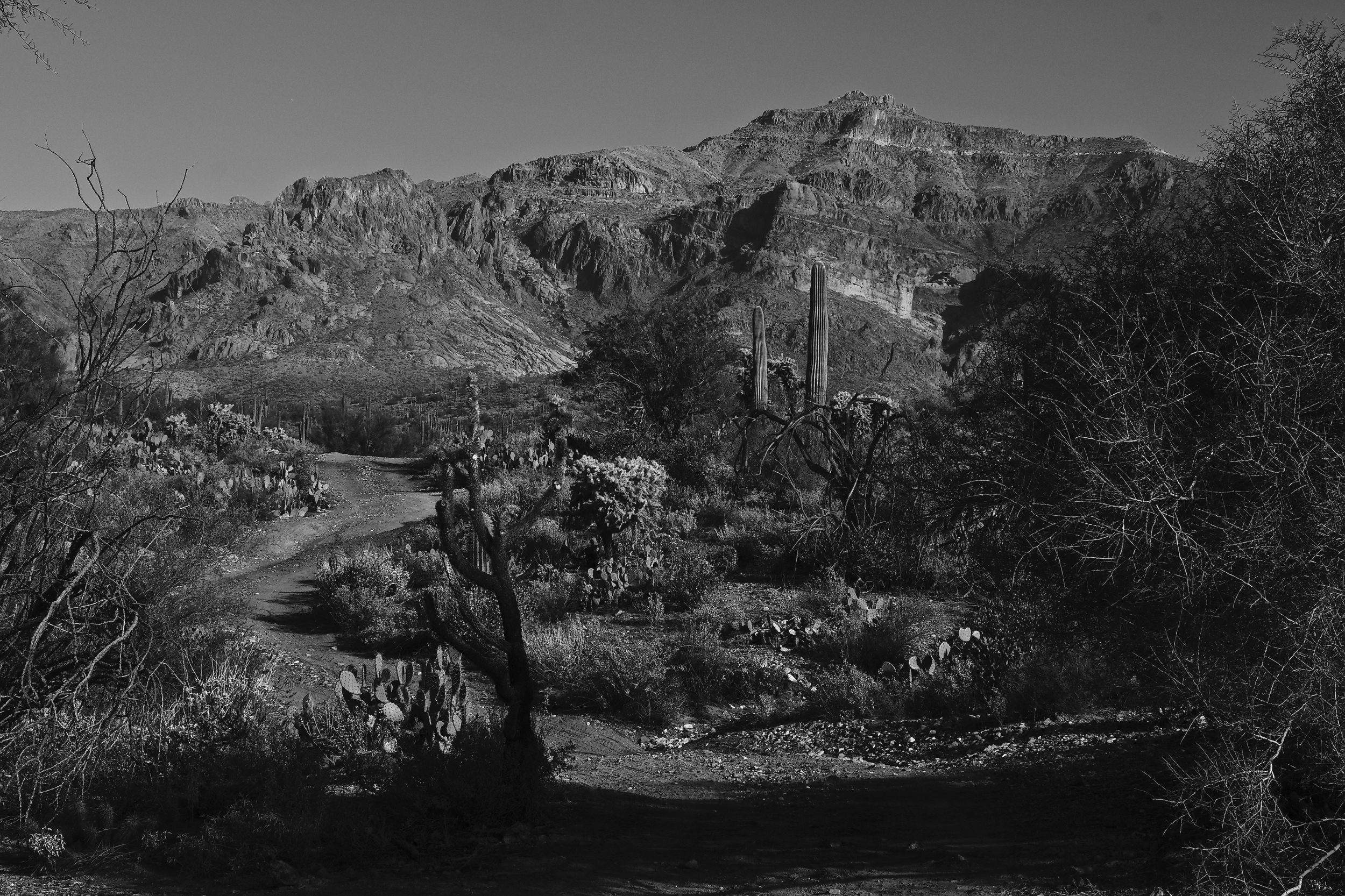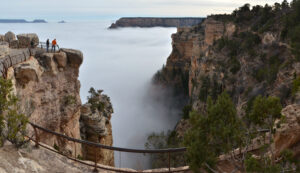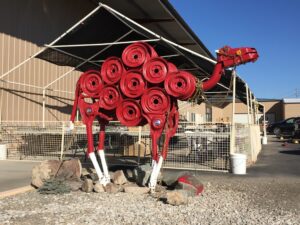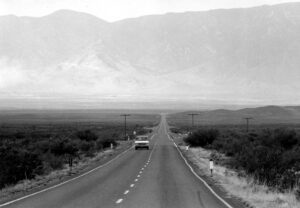Echoes of Arizona

Where History Haunts the Desert
Writer Joseph J. Airdo
In Arizona, the line between history and legend blurs like heat waves rising from desert pavement. The state’s most enduring ghost stories aren’t mere campfire tales spun from imagination — they’re the lingering echoes of real people, documented events and tragedies that carved themselves so deeply into the landscape that they refuse to fade.
These spectral narratives serve as more than entertainment; they’re a unique form of living history, preserving the human drama of Arizona’s frontier past while connecting us to the profound emotions that shaped our state. From the remote North Rim of the Grand Canyon to the vast stretches of territorial highways, these stories remind us that some experiences transcend the boundaries of life and death.
The Wailing Woman



The most haunting cry in Arizona doesn’t come from a coyote or mountain lion — it emanates from the depths of human grief made eternal. Along the Transept Trail at Grand Canyon’s North Rim, hikers report hearing the distinct, plaintive wails of a woman forever searching for what she can never find.
The legend centers on a tragic family vacation in the 1920s, when the Grand Canyon Lodge had just opened its doors to welcome visitors to one of nature’s most spectacular vistas. A mother arrived with her husband and young son, seeking the kind of restorative experience that only the canyon’s majesty could provide. Instead, they found catastrophe.
During what should have been a routine hike along the Transept Trail, a sudden desert storm swept across the rim. The father and son, caught in the tempest’s fury, lost their footing on the treacherous cliff edges and plummeted into the canyon’s depths. The mother, discovering their fate, was consumed by grief so profound that it drove her to madness.
Unable to accept their deaths, she wandered the trail for days, calling out for her lost family. When searchers finally found her, she had taken her own life, choosing to join them rather than live with the unbearable loss. Some accounts suggest she hanged herself within the lodge itself, sealing her connection to both the building and the trail where her world collapsed.
Since then, witnesses have described encountering a translucent figure in a white dress adorned with blue flowers, often wearing a blue scarf that seems to flutter in winds that touch nothing else. Her apparition appears most frequently during or after storms, as if the weather that claimed her family continues to summon her restless spirit.
The Grand Canyon Lodge itself became part of the legend when it burned to the ground in 1932. Witnesses swore they saw the woman’s face appear in the flames, cementing her eternal bond with the structure. When fire again consumed the beloved lodge this summer, destroying not only the historic building but also dozens of surrounding cabins and structures, locals couldn’t help but wonder if the Wailing Woman’s grief had awakened with renewed intensity.
The tragedy of this summer’s fire — caused by lightning and fed by extreme winds — mirrors the suddenness of the original family’s fate. Park forums and social media are abuzz with speculation that the woman’s spirit had grown more restless, unwilling to let another generation of the lodge’s history slip away. The emotional devastation felt by rangers, visitors and local communities who lost what many considered a sacred space only deepened the connection to a story rooted in inconsolable loss.
Hikers continue to report an unmistakable sense of presence along the Transept Trail, particularly in the quiet stretches where forest opens to reveal the canyon’s immensity. Whether the cries they hear belong to the wind, wildlife or something more supernatural, the story endures as a reminder of how swiftly joy can transform into sorrow in the unforgiving beauty of the American West.
The Red Ghost



If the Wailing Woman represents the deepest human emotions made manifest, the Red Ghost embodies the sheer strangeness of Arizona’s territorial period — a time when the improbable became everyday reality and the desert hosted creatures that seemed conjured from fever dreams.
Beginning in spring 1883, near Eagle Creek in eastern Arizona, reports emerged of a massive, reddish beast terrorizing ranchers and prospectors. The first recorded incident was the shocking trampling death of a rancher’s wife, her body discovered surrounded by enormous hoofprints and clumps of coarse, red hair. The only witness later described seeing a huge, red creature “ridden by a devilish figure” as she watched in terror from a window. Her testimony — along with the physical evidence — spawned a wave of sightings and speculation, with subsequent reports claiming the beast carried a human skeleton lashed to its back — a rider from hell itself.
The mysterious creature, which came to be known as the Red Ghost, distinguished itself through a decade of spectacular encounters that read like tall tales but were documented in territorial newspapers. Cowboys attempting to lasso the beast were thrown, charged and terrorized. The creature appeared capable of leaping canyons, eating grizzly bears and vanishing into thin air when cornered. Most disturbing of all, it continued to carry its grisly passenger.
Physical evidence supported the fantastic accounts: massive hoofprints pressed into desert hardpan, clumps of coarse red hair caught on mesquite thorns, and, occasionally, human bones scattered around campsites that had been trampled and destroyed. Prospectors who claimed to have shot at the creature reported hitting the rider’s head, watching bone tumble away while withered flesh and hair remained attached to the skull.
The Red Ghost’s reign of terror ended in 1893 when rancher Mizoo Hastings shot the creature after it trampled his vegetable garden. The body was, in fact, that of a wild camel, bearing deep scars from old leather bindings and revealing a story that begins with one of the most unusual chapters in U.S. military history.
In the 1850s, Secretary of War Jefferson Davis championed an ambitious experiment: importing more than 70 camels from the Middle East to serve as desert transport for western expansion. The U.S. Army’s “Camel Corps” proved initially successful, with the animals demonstrating remarkable endurance in harsh desert conditions. The Civil War and subsequent military reorganizations doomed the experiment. Camels were sold, abandoned or simply released into the wild, left to fend for themselves in the American Southwest. Most adapted poorly to their new environment, but a few survived to become the stuff of legend.
The mystery of the identity of the rider, who had long since vanished when the camel was killed, consumed frontier imaginations. Some theorized it was a lost prospector tied to the camel’s back in hopes the animal would carry him to water. Others suggested a dead soldier, perhaps killed in a camel stampede, who had been lashed down by a practical joker or in a grim act of necessity. The truth died with both the man and the beast.
The Devil’s Highway



While the Wailing Woman and Red Ghost belong to Arizona’s distant past, the legend of the Devil’s Highway bridges historical folklore with modern urban legends, creating a supernatural narrative that evolved throughout the 20th century.
Originally designated as a spur of the famous Mother Road, U.S. Route 666 earned its sinister reputation through a combination of factors: the biblically ominous number, a genuinely dangerous stretch of remote mountain highway and a series of unexplained incidents that transformed a simple road into Arizona’s most feared thoroughfare.
The Arizona portion of U.S. Route 666, running through the White Mountains and Apache-Sitgreaves National Forests, became the epicenter of supernatural encounters. The route’s isolation, sharp curves and high elevation created genuine hazards — animal crossings, wandering livestock and treacherous weather conditions contributed to numerous real accidents, providing a foundation of documented danger upon which legends could flourish.
Local stories centered on specific phenomena that seemed to plague Arizona travelers. Near Alpine, drivers reported encountering a phantom hitchhiker — a young woman in white who appeared alongside the road, vanishing when motorists stopped to offer assistance. The apparition became so well known that some locals avoided the stretch entirely after dark.
More disturbing were accounts of shapeshifting figures darting across the pavement, drawing on Navajo skinwalker traditions from nearby tribal lands. These sightings typically occurred on the portion of U.S. Route 666 closest to reservation boundaries, where ancient beliefs about land spirits and supernatural guardians intersected with modern highway travel.
Truckers developed their own subset of legends, reporting encounters with infernal, wolflike beasts that ran alongside vehicles, sometimes attacking tires or attempting to force drivers off the road. A few claimed to have been stalked by a black sedan that appeared from nowhere, tailgating and swerving aggressively before vanishing without explanation.
Perhaps most unsettling were accounts of “lost time” — travelers who found themselves miles from their intended destinations with no memory of the journey, or who discovered hours had passed during what should have been brief drives. These experiences, reported primarily on remote stretches of the route in Arizona, suggested something beyond ordinary highway hazards.
The psychological impact of the road’s reputation became so pronounced that Arizona officially renumbered its portion of U.S. Route 666 as U.S. Route 191 in 1992. Statistics showed a measurable decrease in reported accidents following the change, attributed partly to drivers’ psychological relief from the infamous “666” designation.
Despite the official renaming, the Devil’s Highway persists as a destination for folklore enthusiasts, motorcycle clubs and thrill-seekers drawn to its dark reputation. The original highway markers, when they can be found, have become collectors’ items, stolen so frequently that the state eventually stopped replacing them.
The stretch from Clifton and Morenci to Alpine remains the most storied portion, where high-altitude forests, tribal land boundaries and genuinely treacherous mountain curves combine to create an atmosphere ripe for supernatural encounters. Local residents sometimes attribute the road’s haunted reputation to conflicts between modern development and ancient land spirits, suggesting that some places resist human intrusion regardless of the century.
These three stories — a mother’s eternal grief, a phantom camel carrying the dead, and a highway that seems to exist partially outside normal reality — demonstrate how Arizona’s harsh beauty and frontier history created perfect conditions for legends that transcend mere folklore. Whether you encounter them as cautionary tales, historical curiosities or genuine supernatural phenomena, Arizona’s ghost stories offer a unique window into the state’s soul.

